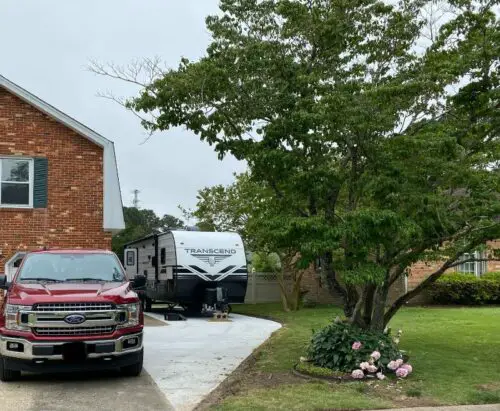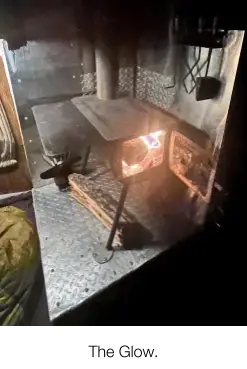I woke up to the sound of the Sunday morning crowd stampeding towards crackling bacon, scrambled eggs and gravy-soaked biscuits. Good morning, Cracker Barrel.
Three weeks into my three-month van camping trip around the Southwestern US, and I was getting close to broke. Between pricey campsites, gas, and groceries, I was burning money faster than I was earning it. Thus, I was now a regular patron of Walmart asphalt landscapes and midwestern breakfast cafe parking lots.
I wanted to find a better way to remain frugal and still enjoy nature. I had signed up for the van life that I had seen on Instagram, waking up in beautiful places, taking pictures at natural monuments, and collecting postcards from every national park. Google told me where I needed to go: BLM land dispersed camping.
Being new to #vanlifing and being an unaccompanied, twenty-something female, I was more than a little nervous to head off the beaten path. But, my God, if I spent one more night trying to put an Instagram filter on a damn parking lot, I was going to pack up and head home.

WHAT IS THIS BLM CAMPING, YOU SAY?
BLM camping is setting up your tent, RV, van, or camper on any of the land that the government has allocated for public use. Camping for next to nothing near some of the most traveled National Parks may seem like it is too good to be true, but that is exactly what BLM land can get you.
(That’s exactly what it got me!)
You can find three types of camping on BLM land:
- Developed campgrounds, which might be free or charge a small fee ($5-$20 per night).
- Dispersed camping, aka boondocking, which are free throughout public land. No permits necessary! Camp wherever you want (within reason, of course).
- Long-Term Visitor Areas, which are seasonally free, otherwise $180 for a 7-month stay September 15 – April 15 of every year. These are popular snowbird gathering spots.
As an RVer, you can take advantage of all three. There’s nothing like just driving down a forgotten access road, pulling to the side, and enjoying a free campsite in the shadow of a mountain!
The Bureau of Land Management (BLM) is a government agency with the responsibility of looking after and allocating federal lands. Located in Grand Junction, Colorado, the BLM headquarters is responsible for governing over ⅛ of America’s land! Within those millions of acres, are lots set aside for public use and camping.
WHERE ARE BLM CAMPSITES LOCATED?
BLM campsites are located across North America. With over 243 million acres of land managed by the BLM, you will never have to travel far to find your next campsite.

- BLM land is almost exclusively in the Western United States past the Rocky Mountains.
- It is concentrated in and around the Great Basin region in Nevada, Utah, Idaho, Colorado, and Arizona.
- You’ll also find big pockets of BLM in the Arizona Sonoran Desert, the New Mexico Chihuahuan desert, and through the Wyoming and Montana Big Sky country.
- However, individual BLM sites are scattered all over the West, from North Dakota to Los Angeles.
Here are some helpful apps and resources for locating public campgrounds:
- FreeCampsites.net.
- Campendium
- BLM website!
You can find more RV apps and resources here.
WHAT IS RV DISPERSED CAMPING?
Dispersed camping is when you camp in the backwoods of public lands and not at a dedicated campsite or private campground.
When it comes to BLM land, dispersed camping is free and fun. Most BLM campgrounds for dispersed camping are traveled enough to make it simple to move around and have created small clearings for easy campsite set up. Dispersed camping is a great option to really get out into the wilderness and enjoy nature at its finest.
However, dispersed camping comes with some rules!
- Park at existing sites. When you camp in an RV or a van, you definitely leave some tire tracks behind. Don’t go making new roads – park in impacted areas. This is part of the Leave No Trace ethic, which is super important on BLM land!
- First come, first served. Arrive early to your campsite if you want the best spot.
- Respect your neighbors. Many people, myself included, enjoy BLM camping for the privacy. If you want to make friends, feel free to chat, but don’t force friendship on your neighbors! And leave the stereo boombox at home, okay? And don’t run a generator at night (better yet, don’t use a generator at all).
- Pack it in, pack it out. Also part of the Leave No Trace ethic, please leave the site in better condition than you found it. Several popular camping spots have been shut down because of trash and graffiti!
- Don’t dump anywhere. Don’t empty your gray tanks in popular areas, or if you’re using soap or chemicals which could negatively impact water sources or wildlife.
- Don’t overstay your welcome. Most BLM camping areas have a 14-day stay limit within a 28-day period. Afterwards, you have to relocate at least 25 miles away!
- Bring drinking water. Most BLM sites are in dry, high-altitude deserts. Bring at least 3 liters of water per person, per day – and that’s just for drinking! You’ll need extra for showers or washing dishes.
BLM CAMPING – THE GOOD
I typed the address of my first BLM dispersed camping area into my GPS and headed out. I was spending the next 4-5 days in Mesa Verde, Colorado.
As an archeology enthusiast, I was thrilled to be spending extra time in a region famous for its cliff dwellings. I was surprised to find that my BLM campsite was less than a mile to the entrance of Mesa Verde National Park! I felt like I was staying in an extension of the park with this campground’s beautiful landscape.
I could not believe this view from my campsite was completely free; however, this campground was also completely dry. There were no toilets, showers, potable water, fire rings, or picnic tables. Luckily, there was a rest area about a mile down the road.
I ended up staying at this campsite for 5 nights while leaving during the day to explore Mesa Verde National Park. Thanks to the incredible experience I had camping on this BLM land, I decided to try another BLM site at my next destination.

Here’s what I’ve learned to love about BLM camping:
- The freedom to improvise. You don’t have to book a campground five months in advance or bet on lottery first-come first-served walk-in reservations. You just … do it!
- Beauty of nature. BLM land is located in some of the most drop-dead gorgeous land in the country. You can take your pick of starry skies, sweeping grasslands, red canyons, or green-filled riverbanks.
- It’s free! You can’t beat free, can you? The Eastern half of the country doesn’t know what they’re missing!
BLM CAMPING – THE BAD
After having such an incredible time at my first BLM campground, I decided to make BLM camping my new thing. After all, I couldn’t beat free camping that was more scenic than a parking lot. But as I pulled into what seemed like a deserted hunting lodge parking lot, I double checked that I was in the right place and sadly, I was. I guess not every BLM campground can be beautiful. I found my way through the overgrown grass to a clearing where I began to set up camp.
I should have checked the weather before setting up my tent because as soon as I had finished, it started raining. I climbed into my tent, thinking it would be a peaceful night of light rain when it began thundering and the rain fell harder and harder until I could feel the water under my tent. I panicked and quickly ran to my car for shelter.
I ended up falling asleep in my car and when I woke up, my tent had moved a few feet “downstream” from a tiny flash flood. I vowed to always triple check the weather before setting up camp again.
Here’s what I don’t always love about RV camping on BLM land:
- You’re at the mercy of the weather. Many BLM lands are truly impassible after a stiff rainstorm. You have to wait for the roads to dry out.
- Access can take a while. While you sometimes luck out with an easy roadside parking spot, you often must drive to some out-of-the-way spots to access great boondocking spots.
- Cell service is spotty at best. Many BLM lands are far, far away from any cellular towers. If you’re a digital nomad in need of internet access, plan ahead!
BLM CAMPING – THE UGLY
After setting up camp on BLM land in Utah, I began my 10-mile trek to and through the National Park. While I love traveling in my van, there is nothing like spending the night out under the stars, especially when the temperature at night is perfect like a late summer in Utah.
When I returned almost 12 hours later, my entire campsite was gone.
I thought perhaps I was lost or wandering the wrong part of the campground, but my GPS told me I was right where I was supposed to be. Someone had stolen my tent, sleeping bag, lanterns, and my duffel bag while I was hiking!
Luckily, I had kept what little valuables I had with me locked in my van (which I would now exclusively be living out of, grr.) I reached out to the local authorities to report the incident, but they said there was not much to go on at all and sadly this sort of thing happened all the time in that area.
While this never happened to me again, I did become more vigilant about what I left out when I left my campsite. I did eventually purchase a new tent and still continue to tent camp on BLM land with or without a companion.
Here’s what I’ve learned to sacrifice while RV camping on BLM public land:
- You’re completely on your own. While boondocking really is pretty safe, you’re still beyond society’s security net. There are no cameras, and often no local law enforcement or cell service. In my case, I learned that lesson the hard way!.
TIPS FOR SAFETY WHILE DISPERSED CAMPING
While dispersed camping can be fun and adventurous, it is important to keep safety in the forefront of your planning. When you are trekking into the backcountry or camping in an undeveloped area, there can be things that turn serious very quickly.
Always bring water with you.
Most BLM land does not have potable water for drinking purposes. Be sure to have enough water for time planned as well as a few extra gallons in case of an emergency.
Keep friends or family in the loop.
Always be sure to check in with a dedicated friend or family member when camping, either dispersed or traditional. Tell this person where you are going and when you plan on being back. Be sure to update them when you arrive and leave. This person should not be afraid to contact local authorities if you do not provide them with an update after a set number of hours.
Get to know the area.
While bears or rattlesnakes may not be a concern when you are in your home state, they are a big concern when staying in Colorado. Be sure to read up on local wildlife and vegetation to avoid a potentially dangerous situation.
Feel the space out.
If you do not feel comfortable, LEAVE. Whether it is an odd campground companion or an incoming storm, have a backup list of places to stay just in case.
Check the weather.
No one likes to camp in a rainstorm, but dispersed camping can become dangerous quickly. The area could be prone to flash floods. A strong wind could knock large branches from a nearby tree. A tornado developing could be common for that area. In inclimate weather situations, it is best to stay in town or even at a rest stop that could provide shelter in case of an emergency.
WHERE ARE THE BEST BLM CAMPSITES?
Leaving behind the noise and crowds of society is one big perk of camping. You set off to get some fresh air but when you arrive at your campsite, you see it’s FULL of people! BLM land allows you to spread out and get away from everything (and everyone).

Here’s a list of five favorite BLM campsites located throughout America:
- Joshua Tree National Park located in California allows for dispersed camping just beyond the north or south gates of the park. Known for its awe-inspiring Mojave landscape and ecosystems, Joshua Tree National Park is top of many traveler’s must see lists.
- Dinosaur National Monument is located in Colorado. Known for its historical findings of actual dinosaur bones, this park is also a dark sky park, making it perfect for a night of stargazing. Find the perfect campsite to stretch out your sleeping bags!
- Black Canyon of the Gunnison National Park is another dark sky park providing some of the best views of the milky way in North America. Fall in love with the breathtaking views both day and night before settling into your BCOG campsite.
- Carlsbad Caverns National Park is full of amazing natural architecture. Home to over 100 caves, this national park provides impressive daytime sightseeing and beautiful BLM New Mexico camping spots.
- Moab is a gorgeous city in Utah that is the gateway to Arches National Park. Known for its breathtaking red stone archways, Arches National Park is a must see destination for many outdoor enthusiasts. BLM manages 26 campgrounds around Moab.
***
Camping on BLM lands can be the perfect amount of adventure and frugality. Trekking into the backcountry near America’s national parks and natural monuments to set up camp can be exciting and pretty safe if you know how to prepare properly. It takes a few outings to really get the hang of it, but once you start camping on BLM land, you’ll wonder why you didn’t start doing it sooner!
So do what I did: Say goodbye to Cracker Barrel parking lots. Say hello to waking up to the American wilderness like a true modern nomad!
Sara Sabharwal is a modern digital nomad exploring the world one road trip at a time. She splits her time between North America and India and has yet to find a place that she didn’t fall in love with. Her favorite destinations include dark sky parks and forested mountain ranges. My dream is to live in a van down by the river, which I luckily get to do 3-6 months out of the year.
-
Sara Sabharwalhttps://changingears.com/author/sara-sabharwal/
-
Sara Sabharwalhttps://changingears.com/author/sara-sabharwal/
-
Sara Sabharwalhttps://changingears.com/author/sara-sabharwal/
-
Sara Sabharwalhttps://changingears.com/author/sara-sabharwal/









